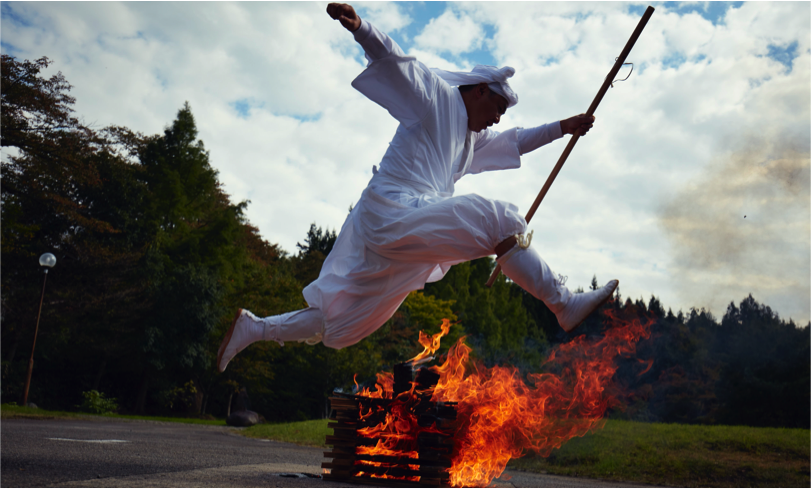By Pip Stewart
Travel, for me at least, is a way to connect to yourself, others and the natural world around you.
Before moving back to the UK I lived and worked in Asia and Japan always fascinated me – the fast-paced modernity combined with a rich and deep traditional culture. Needless to say, when I was invited to the Tohoku region of Japan to experience the spiritual side of the country I was there faster than you can say “om”.
From walking meditations with the Yamabushi, meditating with zen monks, to channelling my inner samurai, here are the 5 wellness lessons I took from that trip. I hope will serve me (and perhaps you) well in 2019.
1. Stop putting pressure on yourself to succeed
 Copyright © Japan National Tourism Organization
Copyright © Japan National Tourism Organization
Ease up on yourself, relax. No seriously, do. Ironically you can achieve more when you’re more chilled out and less uptight. “A tree floats on water,” my kendo teacher, or sensai, told me as I clenched my whole body to strike my opponent. “Relax, flow”. Ironically, when I did my hits became more accurate.
I dared not celebrate though. I was warned that in Kendo, even at the Olympics, if an athlete celebrates a victory the judge can remove it from them because it goes against the spirit of respect for your opponent. I thought this was also a beautiful way of accepting that sometimes we are up in life, and sometimes we are down – your success shouldn’t come at the expense of others.
Turns out true badassery, true success, the true spirit of the samurai, is about relaxing and having respect for those around you.
2. Accept that sometimes things don’t go your way
 Copyright © Japan National Tourism Organization
Copyright © Japan National Tourism Organization
The Yamabushi were traditionally mountain hermits who used nature as a way healing and I was invited to join them in a ritual. Today the practise has opened up even Tokyo’s busy professionals take to the mountains as way of rebalancing themselves. The experience can last from a few days to a week.
Acceptance is at the heart of the Yamabushi’s practise. In nature you can’t battle against rain or thunder, it just happens, you can’t change it. This was the lesson I was meant to learn as I followed silently in the footsteps of my Yamabushi guide as we trekked over three spiritual mountains in the Tohoku region. You have to accept your situation, even if it’s uncomfortable – accept things, and yourself, as they are. In this case I also had to accept I was never going to keep my white robes clean for very long…
3. Visualise nature healing you
 Copyright © Japan National Tourism Organization
Copyright © Japan National Tourism Organization
“Cry like a child being born,” my Yamabushi guide told me as I focused on the flames and ran towards them. My word, it felt cathartic as I screamed like a banshee…
In the Yamabushi practise nature is used as a way of refreshing the soul. During the hike in Tohoku we crossed three mountains – Hagorusan, Gassan and Yudonosan – which represent the present, past and future. Rivers are a place to let your wash away your regrets and worries – and jumping over fire at the end of the practise is a chance to be reborn, start afresh, stronger and more in tune with yourself and nature.
This spiritual practise was fascinating to me, mainly because by the end of the hike I did feel completely different. Perhaps it was visualising, using the landscape as an emotional tool, or perhaps it was just about being in nature, but these techniques are definitely ones I brought home with me.
Try it? Next time you go on a walk picture leaving your worries somewhere and starting again. Let me know how you get on…
4. Think of your body as part of nature
 Copyright © Japan National Tourism Organization
Copyright © Japan National Tourism Organization
How often have you negatively critiqued a tree, flower, mountain for the way it looks? Exactly… Yet I’ll hazard a guess that we’ve all given our bodies so much negative self talk and likely little thanks for hauling us over mountains, across rivers and through valleys.
I was initially nervous of stripping off but my Japanese friends assured me that because of the long history and tradition of onsens in Japan no-one bats an eyelid about these things. There’s something about being eu natural in nature that feels, well, natural. I actually found it massively liberating! After all, it’s just a bod, with lumps, bumps, wrinkles and dimples that does a beautiful job of keeping us alive.
My trip to Ashina’s onsen was a treat for the mind, body and soul. There is something massively comforting about being cocooned in warm water whilst watching leafs dance around outside the window. I definitely had a sense of both being in nature and a part of it. If you haven’t already tried it, I can highly recommend giving it a go…
5. Do things without expectation of benefit

Copyright © Japan National Tourism Organization
The zen monk handed me the green matcha tea he’d prepared with such care and love I wanted to cry. The way he had made the tea, from pouring the water into the bowl, to the gentle way he mixed in the matcha paste, was beautiful, deliberate and slow – a far cry from whacking the kettle on at home and chucking a tea bag in a teapot.
As the green tea came to stillness in the bowl before me I reflected that this was the most beautifully presented drink I’d ever been given.
I asked him after if his deliberate movements meant anything. He looked confused.
“Do not think to get something from the experience”, he said, “that’s desire, which isn’t good. Just do it, just focus on what you’re doing.”
Ironically, it was a life lesson served in a teacup…
Want to try a spiritual trek in Japan’s Tohoku area yourself? Find out more here:
https://jnto.tohokumoment.com/en/spiritual-trekker/

